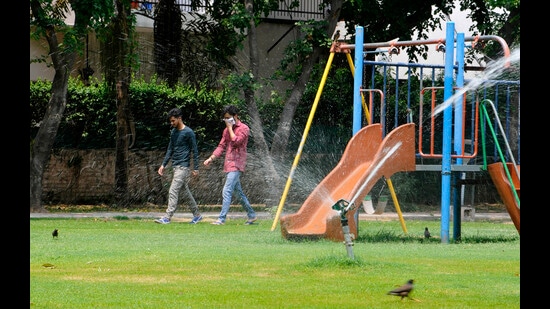Chandigarh MC plans to expand tertiary water network
Currently saving potable water worth nearly ₹36 crore every year by recycling, the Chandigarh municipal corporation (MC) now aims to expand the tertiary water supply network, which will save ₹60 crore and nearly 100 million litre per day (MLD) of precious drinking water
Currently saving potable water worth nearly ₹36 crore every year by recycling, the Chandigarh municipal corporation now aims to expand the tertiary water supply network, which will save ₹60 crore and nearly 100 million litre per day (MLD) of precious drinking water.

MC commissioner Anindita Mitra, said, “MC plans to increase usage of the tertiary water. Currently, MC is saving 70 MLD of potable water by recycling sewage water. We now plan to increase it to 100 MLD by expanding the tertiary water supply network in Industrial Area and areas in the city yet to be covered.”
The project envisages modernisation of the entire tertiary water supply system as the already laid network also requires upgrading. In addition to it, left-out pockets like government institutions, particularly schools, will be covered. Some of the southern sectors which haven’t been covered so far will also be connected.
Providing tertiary water for agriculture and related activities is one of the major objectives of the project as it will reduce dependence on ground water.
By expanding the tertiary network, MC will also save on water pumping costs. “By recycling and usage of 70 MLD tertiary water, MC saves ₹3 crore per month. After increasing tertiary water usage, savings will increase to more than ₹5 crore per month,” said Mitra.
Three-decade system expansion and upgrade
The civic body started laying tertiary treated water pipelines in 1990 and covered Sectors 1 to 12 and Sector 16 initially. At present, almost 80% of the city has been covered.
Under the Water Bylaws 2015, MC made tertiary treated water connection mandatory for all houses having an area of 1 kanal (500 square yards) and above. However, the supply still hasn’t been extended to all houses eligible for the connection, even though they are paying the charges. There are around 7,000 houses eligible for TT water connection, of which around 2,000 have been covered.
Sensors, STP upgrade
Residents have for long complained about the erratic supply of tertiary water. Also, most don’t use it because of the foul smell associated with it.
In a bid to improve tertiary water quality, a Supervisory Control and Data Acquisition (SCADA) centre has been created. The existing pipelines has been equipped with sensors, which monitor water pressure and quality with live feed. The field staff is updated regularly so that they can take corrective measures.
MC has also taken up an aeration project to reduce the smell in the water. There are four underground reservoirs from which the tertiary water is pumped across the city. Here, MC has taken up aeration process to minimise the smell.
“To improve the quantity and quality of tertiary water, five sewage treatment plants (STPs) – Diggian, Dhanas, 3BRD, Raipur Kalan and Raipur Khurd are being upgraded. The current tertiary water has BOD of around 30, after new plants, it will be less than 5, which will make usable for car wash in houses also,” said the MC official.
What is tertiary treated water?
After undergoing a chemical treatment and sedimentation process, sewerage water is made suitable for watering lawns and parks as well for irrigating fields. Tertiary treatment is the final cleaning process that improves wastewater quality before it is reused or recycled. Its bio-chemical oxygen demand (BOD) should be less than 10 mg.





